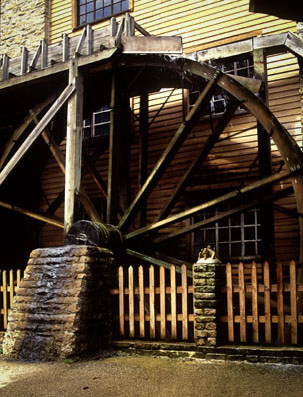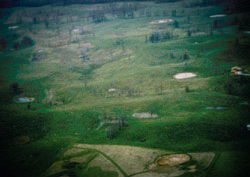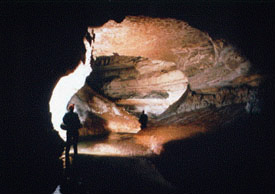
Mill water wheel at Spring Mill State Park.
Spring Mill State Park is located near the town of Mitchell, Lawrence County, in south-central Indiana. The park has a variety of historical and natural attractions such as the restored pioneer village and interesting caves and is visited by nearly three-quarters of a million people each year. It is part of the very limited habitat of northern blind cave fish in Indiana, and Spring Mill Lake has considerable recreational potential.
The
The source of the water entering the park and Spring Mill Lake and its chemical composition, biologic condition, and

Plugged sinkholes form ponds that dot the landscape of the Mitchell Plateau.
Nitrogen enrichment and
Two primary sets of information were needed. First, we needed to precisely define the limits of the drainage area
of Spring Mill Lake. Geologists used

The tranquil waters of Spring Mill Lake may be threatened by harmful contaminants.

Several caves in the park are home to a relatively large population of rare northern blind cave fish.

Caves form a vast network of underground passageways at Spring Mill State Park.
Secondly, to formulate a plan to provide information to help landowners in the surrounding area, it was necessary to identify the kind and amount of chemical and biologic contaminants as well as the amount of mud and silt entering the lake. Major variations in the quality of the water were expected between times of low water flow and after storms. Variations were also expected to occur throughout the year because of seasonal events, such as tillage; application of fertilizers to cropland; application of pesticides to highway and railroad right of ways, as wellimage as to cropland; and use of chemicals to de-ice roads in winter.
It was necessary to monitor water volume and quality over a four-year period to establish baseline information needed for planning for the future of Spring Mill Lake and its relation to human usage and conservation of the cave life. Monitoring concentrated on the major springs in the park although precipitation was measured at several stations around the area to learn the input into the karst system.
For additional information about the geology of the park, contact Nancy Hasenmueller (hasenmue@indiana.edu) at the Indiana Geological Survey, 1001 E. 10th St., Bloomington, IN 47405.
For more information about the park, go to the Spring Mill State Park Web page.


